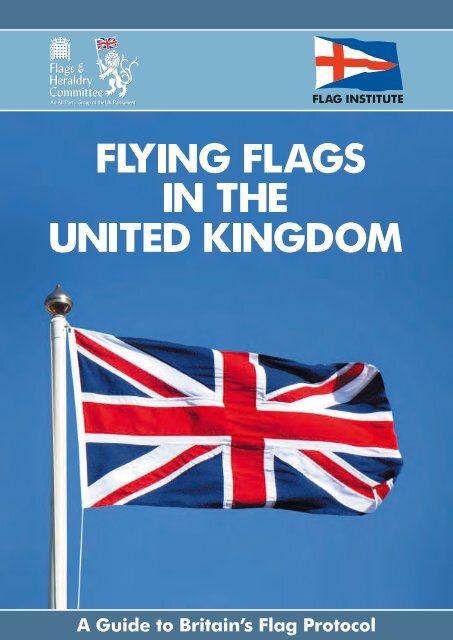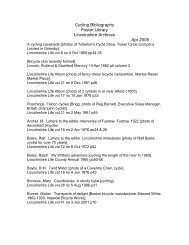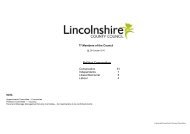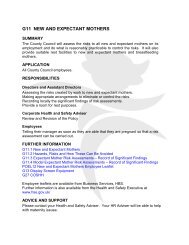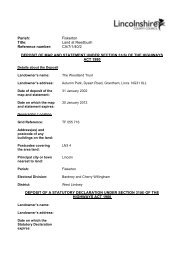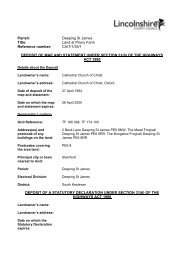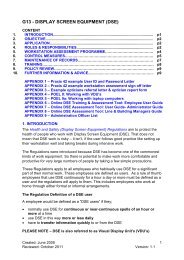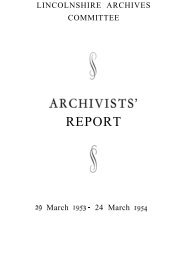Flying flags in the United Kingdom - A guide to Britain's flag protocol
Flying flags in the United Kingdom - A guide to Britain's flag protocol
Flying flags in the United Kingdom - A guide to Britain's flag protocol
Create successful ePaper yourself
Turn your PDF publications into a flip-book with our unique Google optimized e-Paper software.
A Guide <strong>to</strong> Brita<strong>in</strong>’s Flag Pro<strong>to</strong>col
Introduction<br />
The Union Flag is one of <strong>the</strong> best-known national symbols <strong>in</strong> <strong>the</strong> world. This<br />
is not surpris<strong>in</strong>g as it has been around for over 400 years with only m<strong>in</strong>or<br />
changes. The Union Flag signifies <strong>the</strong> unity of <strong>the</strong> nations that make up <strong>the</strong><br />
<strong>United</strong> K<strong>in</strong>gdom and dependencies, and demonstrates <strong>the</strong> bonds of citizenship<br />
which we all share. Whatever our differences may be, whatever our<br />
faith, culture, political views, ethnicity, first language or traditional cus<strong>to</strong>ms,<br />
we can all stand beneath this <strong>flag</strong> united <strong>to</strong>ge<strong>the</strong>r <strong>in</strong> common purpose.<br />
But for <strong>to</strong>o long our <strong>flag</strong> has been taken for granted and largely ignored.<br />
Few children are taught about it <strong>in</strong> school, few people know its his<strong>to</strong>ry or<br />
even <strong>the</strong> correct way <strong>to</strong> fly it. It is time that this changed and we became<br />
familiar with our <strong>flag</strong>, because all of us have <strong>the</strong> right <strong>to</strong> fly <strong>the</strong> <strong>flag</strong> and<br />
may use it on land wherever and whenever we wish. It is <strong>the</strong> people’s <strong>flag</strong><br />
as well as <strong>the</strong> state <strong>flag</strong>.<br />
The Flag Institute, <strong>in</strong> association with <strong>the</strong> Flags & Heraldry Committee,<br />
an all party group of <strong>the</strong> <strong>United</strong> K<strong>in</strong>gdom Parliament, has produced this<br />
booklet <strong>to</strong> help and <strong>guide</strong> you when fly<strong>in</strong>g <strong>the</strong> <strong>flag</strong> <strong>in</strong> a variety of situations -<br />
it provides a few simple rules <strong>to</strong> ensure that <strong>the</strong> <strong>flag</strong> is flown correctly and<br />
is treated with dignity and respect.<br />
We would like <strong>to</strong> pay tribute <strong>to</strong> Graham Bartram, Chief Vexillologist of<br />
<strong>the</strong> Flag Institute, for his outstand<strong>in</strong>g graphics and detailed knowledge<br />
<strong>in</strong> <strong>the</strong> draft<strong>in</strong>g of this booklet, and also <strong>to</strong> officials at <strong>the</strong> Department for<br />
Culture, Media and Sport (DCMS) who so k<strong>in</strong>dly supported this venture.<br />
Above all we hope this booklet will encourage you <strong>to</strong> fly your <strong>flag</strong> with<br />
affection and pride.<br />
Malcolm Farrow OBE<br />
President of <strong>the</strong> Flag Institute<br />
March 2010<br />
Andrew Ros<strong>in</strong>dell MP<br />
Chairman of <strong>the</strong> Flags & Heraldry Committee<br />
BRITISH FLAG PROTOCOL<br />
1
BRITISH FLAG PROTOCOL<br />
2<br />
Introduction .................................................................1<br />
The Union Flag ............................................................ 3<br />
The Flag Pro<strong>to</strong>col of <strong>the</strong> <strong>United</strong> K<strong>in</strong>gdom .................. 3<br />
<strong>Fly<strong>in</strong>g</strong> <strong>the</strong> Flag ............................................................. 3<br />
Position of Honour................................................. 3<br />
In Front of and On a Build<strong>in</strong>g ............................... 4<br />
With<strong>in</strong> a Circle of Flags .......................................... 4<br />
From a Flagpole with Yardarm and Gaff ............... 5<br />
In Processions ........................................................ 5<br />
With Crossed Flags ................................................. 5<br />
Suspended Vertically Above a Street ...................... 5<br />
Flat Aga<strong>in</strong>st a Surface ............................................. 5<br />
On a Speaker’s Platform ......................................... 6<br />
Double-Flagg<strong>in</strong>g ..................................................... 6<br />
As a Pall for a Coff<strong>in</strong> ............................................... 6<br />
<strong>Fly<strong>in</strong>g</strong> Flags <strong>in</strong> <strong>the</strong> <strong>United</strong> K<strong>in</strong>gdom - A Guide <strong>to</strong> Brita<strong>in</strong>’s Flag Pro<strong>to</strong>col<br />
First published <strong>in</strong> <strong>the</strong> <strong>United</strong> K<strong>in</strong>gdom <strong>in</strong> 2010 by <strong>the</strong> Flag Institute <strong>in</strong> association with<br />
<strong>the</strong> Flags and Heraldry Committee of <strong>the</strong> UK Parliament and with support from <strong>the</strong><br />
Department for Culture, Media and Sport.<br />
Copyright © The Flag Institute 2010<br />
Graham Bartram has asserted his rights under <strong>the</strong> Copyright, Designs and Patent Act<br />
1988 and <strong>the</strong> Berne Convention on Copyright <strong>to</strong> be identified as <strong>the</strong> author of this work.<br />
All rights reserved. No part of this booklet may be reproduced, s<strong>to</strong>red <strong>in</strong> a retrieval<br />
system or transmitted <strong>in</strong> any way or by any means, electronic, mechanical, pho<strong>to</strong>copy<strong>in</strong>g,<br />
record<strong>in</strong>g or o<strong>the</strong>rwise without <strong>the</strong> prior written permission of <strong>the</strong> copyright holder.<br />
Whilst every care has been taken <strong>in</strong> <strong>the</strong> preparation of this booklet, nei<strong>the</strong>r <strong>the</strong> publishers<br />
nor <strong>the</strong> author assume any responsibility for errors or omissions, or for damages<br />
result<strong>in</strong>g from <strong>the</strong> use of <strong>the</strong> <strong>in</strong>formation conta<strong>in</strong>ed here<strong>in</strong>.<br />
ISBN 978-0-9513286-1-3<br />
Pr<strong>in</strong>ted and bound <strong>in</strong> <strong>the</strong> <strong>United</strong> K<strong>in</strong>gdom by pr<strong>in</strong>t<strong>in</strong>g.com.<br />
Image Credits<br />
Illustrations: Graham Bartram<br />
Front Cover: Donald Edwards<br />
Inside Front Cover (left <strong>to</strong> right, <strong>to</strong>p <strong>to</strong> bot<strong>to</strong>m): Adrian Dennis - AFP; Malcolm Farrow;<br />
René Mansi † ; Douglas Freer † ; Dan Kite † ; Arthur M; Mat<strong>the</strong>w Dixon † ; Marek Slusarczyk † ;<br />
Donald Edwards<br />
Page 1: Paul Kemp<br />
Inside Back Cover (left <strong>to</strong> right, <strong>to</strong>p <strong>to</strong> bot<strong>to</strong>m): Graham Heywood † ; Col<strong>in</strong> Dobson;<br />
Arthur M; Mark Bridge; Jim Oatway; Don Bayley † ; Graham Bartram; dit<strong>to</strong>; dit<strong>to</strong><br />
† from iS<strong>to</strong>ckPho<strong>to</strong>.com<br />
On Vehicles .............................................................7<br />
On Uniforms ...........................................................7<br />
At Civilian Transport Facilities ................................7<br />
Pennants .......................................................................7<br />
The Royal Standard ......................................................7<br />
Flags at Half-mast ........................................................ 8<br />
The Proper Disposal of Flags ...................................... 8<br />
Appendix A - British Flags ........................................... 9<br />
Appendix B - Precedence of Flags ..............................13<br />
General Precedence ..............................................13<br />
Order for Commonwealth Events ........................13<br />
Order for <strong>United</strong> Nations Events ...........................14<br />
Order for European Union Events ........................14<br />
English Alphabetical Order ...................................14<br />
Appendix C - <strong>United</strong> K<strong>in</strong>gdom Flag Specifications ....16
The Union Flag<br />
The national <strong>flag</strong> of <strong>the</strong> <strong>United</strong> K<strong>in</strong>gdom, <strong>the</strong> Crown Dependencies and Overseas<br />
Terri<strong>to</strong>ries is <strong>the</strong> Union Flag, which may also be called <strong>the</strong> Union Jack. 1<br />
The first Union Flag was created <strong>in</strong> 1606 and comb<strong>in</strong>ed <strong>the</strong> <strong><strong>flag</strong>s</strong> of England<br />
and Scotland. The present Union Flag dates from 1801 when St. Patrick’s<br />
Cross was added <strong>to</strong> represent Ireland. It <strong>the</strong>n became possible <strong>to</strong> display <strong>the</strong><br />
<strong>flag</strong> upside down. There is no Flag Act <strong>in</strong> UK law and <strong>the</strong> Union Flag is <strong>the</strong><br />
national <strong>flag</strong> by long established cus<strong>to</strong>m and practice, ra<strong>the</strong>r than by statute.<br />
The Flag Pro<strong>to</strong>col of <strong>the</strong> <strong>United</strong> K<strong>in</strong>gdom<br />
The national <strong><strong>flag</strong>s</strong> of <strong>the</strong> <strong>United</strong> K<strong>in</strong>gdom (ie. <strong>the</strong> Union Flag and <strong>the</strong> <strong><strong>flag</strong>s</strong><br />
of England, Scotland and Wales) should be displayed only <strong>in</strong> a dignified<br />
manner befitt<strong>in</strong>g <strong>the</strong> national emblems. They should not be displayed <strong>in</strong> a<br />
position <strong>in</strong>ferior <strong>to</strong> any o<strong>the</strong>r <strong>flag</strong> or ensign.<br />
It is improper <strong>to</strong> use <strong>the</strong> national <strong><strong>flag</strong>s</strong> as a table or seat cover or as a<br />
mask<strong>in</strong>g for boxes, barriers, or <strong>the</strong> <strong>in</strong>terven<strong>in</strong>g space between a dais or<br />
platform and <strong>the</strong> floor. The use of any of <strong>the</strong> national <strong><strong>flag</strong>s</strong> <strong>to</strong> cover a statue,<br />
monument or plaque for an unveil<strong>in</strong>g ceremony is discouraged.<br />
<strong>Fly<strong>in</strong>g</strong> <strong>the</strong> Flag<br />
Flags may be flown on every day of <strong>the</strong> year. Government and local authority<br />
build<strong>in</strong>gs <strong>in</strong> England, Scotland and Wales are encouraged <strong>to</strong> fly national<br />
<strong><strong>flag</strong>s</strong> every day of <strong>the</strong> year (<strong>the</strong> fly<strong>in</strong>g of <strong><strong>flag</strong>s</strong> at certa<strong>in</strong> locations <strong>in</strong> Nor<strong>the</strong>rn<br />
Ireland is constra<strong>in</strong>ed by The Flags Regulations [Nor<strong>the</strong>rn Ireland] 2000<br />
and Police Emblems and Flag Regulations [Nor<strong>the</strong>rn Ireland] 2002). 2<br />
Flags are normally flown from sunrise <strong>to</strong> sunset but <strong>the</strong>y may also be<br />
flown at night, when <strong>the</strong>y should be illum<strong>in</strong>ated.<br />
No permission is needed <strong>to</strong> fly <strong>the</strong> national <strong><strong>flag</strong>s</strong> and <strong>the</strong>y are excluded<br />
from most plann<strong>in</strong>g and advertis<strong>in</strong>g regulations (but <strong>flag</strong>poles may not be).<br />
National <strong><strong>flag</strong>s</strong> should never be flown <strong>in</strong> a worn or damaged condition, or<br />
when soiled. To do so is <strong>to</strong> show disrespect for <strong>the</strong> nations <strong>the</strong>y represent.<br />
Important: <strong>the</strong> Union Flag has a correct way up - <strong>in</strong> <strong>the</strong> half of <strong>the</strong> <strong>flag</strong><br />
nearest <strong>the</strong> <strong>flag</strong>pole, <strong>the</strong> wider diagonal white stripe must be above <strong>the</strong><br />
red diagonal stripe, as Scotland’s St Andrew’s Cross takes precedence over<br />
Ireland’s St. Patrick’s Cross. It is most improper <strong>to</strong> fly <strong>the</strong> <strong>flag</strong> upside down.<br />
If a purely decorative effect is desired it is better <strong>to</strong> conf<strong>in</strong>e <strong>the</strong> display <strong>to</strong><br />
<strong><strong>flag</strong>s</strong> of lesser status; for example, house <strong><strong>flag</strong>s</strong>, pennants or coloured bunt<strong>in</strong>g.<br />
Position of Honour<br />
The order of precedence of <strong><strong>flag</strong>s</strong> <strong>in</strong> <strong>the</strong> UK is: Royal Standards, <strong>the</strong> Union Flag,<br />
<strong>the</strong> <strong>flag</strong> of <strong>the</strong> host country (England, Scotland, Wales, etc.), <strong><strong>flag</strong>s</strong> of o<strong>the</strong>r<br />
nations (<strong>in</strong> alphabetical order, see <strong>the</strong> list on page 15), <strong>the</strong> Commonwealth<br />
Flag, <strong>the</strong> European Union Flag, county <strong><strong>flag</strong>s</strong>, <strong><strong>flag</strong>s</strong> of cities or <strong>to</strong>wns, banners<br />
of arms, and house <strong><strong>flag</strong>s</strong>. See Appendix B (page 13) for a detailed precedence<br />
list and special precedence orders for <strong>in</strong>ternational organizations.<br />
When British national <strong><strong>flag</strong>s</strong> are flown with <strong>the</strong> <strong><strong>flag</strong>s</strong> of o<strong>the</strong>r nations<br />
each <strong>flag</strong> should be <strong>the</strong> same size (or have <strong>the</strong> same width - <strong>the</strong> measure-<br />
1 See Hansard - House of Lords Debate 14 July 1908 vol 192 cc 579 - 80.<br />
2 See www.opsi.gov.uk/Sr/sr2000/nisr_20000347_en.pdf & www.opsi.gov.uk/Sr/sr2002/20020023.htm<br />
The First Union Flag<br />
The Modern Union Flag<br />
This <strong>flag</strong> is upside down!<br />
BRITISH FLAG PROTOCOL<br />
3
BRITISH FLAG PROTOCOL<br />
4<br />
1. Fold <strong>in</strong> half<br />
2. Fold <strong>in</strong> half aga<strong>in</strong><br />
3. Fold <strong>the</strong> last 1/3 <strong>in</strong>wards<br />
4. Roll <strong>to</strong>wards <strong>the</strong> head<strong>in</strong>g<br />
5. Tie with light cot<strong>to</strong>n<br />
6. The <strong>flag</strong> is now ready for<br />
break<strong>in</strong>g<br />
Fold<strong>in</strong>g a Flag for Break<strong>in</strong>g<br />
ment from <strong>to</strong>p <strong>to</strong> bot<strong>to</strong>m) and should fly from a separate <strong>flag</strong>pole of <strong>the</strong><br />
same height. 3 The UK’s <strong>flag</strong> shape of 3:5 works well with nearly all o<strong>the</strong>r<br />
nations’ <strong><strong>flag</strong>s</strong> and it is recommended <strong>to</strong> use <strong>the</strong>se proportions if a standard<br />
size is required for all <strong>the</strong> <strong><strong>flag</strong>s</strong> <strong>in</strong> a display. 4<br />
The senior British national <strong>flag</strong> (eg. <strong>the</strong> Union Flag or <strong>the</strong> <strong>flag</strong> of England,<br />
Scotland or Wales) should be raised first and lowered last, unless all<br />
<strong>the</strong> <strong><strong>flag</strong>s</strong> can be raised and lowered simultaneously. Flags should be raised<br />
and lowered <strong>in</strong> a dignified manner. An alternative British tradition for <strong>flag</strong><br />
rais<strong>in</strong>g is <strong>to</strong> hoist <strong>the</strong> <strong>flag</strong> while rolled up and secured with a th<strong>in</strong> piece of<br />
cot<strong>to</strong>n or a slip knot. A sharp tug of <strong>the</strong> halyard will break <strong>the</strong> cot<strong>to</strong>n and<br />
release <strong>the</strong> <strong>flag</strong> <strong>to</strong> fly free. This is known as ‘break<strong>in</strong>g’ <strong>the</strong> <strong>flag</strong>, and is sometimes<br />
used <strong>to</strong> signal <strong>the</strong> beg<strong>in</strong>n<strong>in</strong>g of an event, or <strong>the</strong> arrival of a VIP.<br />
National <strong><strong>flag</strong>s</strong> should be displayed as follows:<br />
In Front of and On a Build<strong>in</strong>g<br />
Where <strong>the</strong>re are two or more <strong>flag</strong>poles parallel <strong>to</strong> <strong>the</strong> build<strong>in</strong>g l<strong>in</strong>e, <strong>the</strong><br />
senior national <strong>flag</strong> should be <strong>the</strong> first <strong>flag</strong> on <strong>the</strong> left of an observer fac<strong>in</strong>g<br />
<strong>the</strong> ma<strong>in</strong> entrance of <strong>the</strong> build<strong>in</strong>g. The rema<strong>in</strong><strong>in</strong>g <strong><strong>flag</strong>s</strong> <strong>the</strong>n appear <strong>in</strong> order<br />
of precedence from left <strong>to</strong> right.<br />
Where <strong>the</strong>re are two or more <strong>flag</strong>poles on <strong>the</strong> forecourt of a build<strong>in</strong>g<br />
angled <strong>to</strong> <strong>the</strong> ma<strong>in</strong> entrance, <strong>the</strong> senior national <strong>flag</strong> should be flown on<br />
<strong>the</strong> outermost pole when <strong>the</strong> <strong>flag</strong>poles are <strong>to</strong> <strong>the</strong> left of <strong>the</strong> ma<strong>in</strong> entrance<br />
and on <strong>the</strong> <strong>in</strong>nermost pole when <strong>the</strong> <strong>flag</strong>poles are <strong>to</strong> <strong>the</strong> right of <strong>the</strong> ma<strong>in</strong><br />
entrance, as shown <strong>in</strong> <strong>the</strong> diagram.<br />
If only one <strong>flag</strong> is <strong>to</strong> be flown and <strong>the</strong>re are two <strong>flag</strong>poles, it should be<br />
flown on <strong>the</strong> <strong>flag</strong>pole <strong>to</strong> <strong>the</strong> observer’s left. If <strong>the</strong>re are more than two <strong>flag</strong>poles,<br />
it should be flown as near as possible <strong>to</strong> <strong>the</strong> centre. This only applies<br />
when <strong>the</strong> o<strong>the</strong>r <strong>flag</strong>poles rema<strong>in</strong> empty. It is permissible <strong>to</strong> fly <strong>the</strong> same<br />
national <strong>flag</strong> on more than one <strong>flag</strong>pole by repeat<strong>in</strong>g <strong>the</strong> order of precedence.<br />
If one <strong>flag</strong>pole is higher than <strong>the</strong> rest, <strong>the</strong>n <strong>the</strong> senior national <strong>flag</strong> can<br />
fly from that <strong>flag</strong>pole; however no non-UK national <strong><strong>flag</strong>s</strong> can be flown on<br />
<strong>the</strong> o<strong>the</strong>r <strong>flag</strong>poles. These can be used for more junior <strong><strong>flag</strong>s</strong> such as county<br />
and house <strong><strong>flag</strong>s</strong>. Alternatively <strong>the</strong> higher <strong>flag</strong>pole can be left empty and <strong>the</strong><br />
rema<strong>in</strong><strong>in</strong>g <strong>flag</strong>poles used. In general when sit<strong>in</strong>g <strong>flag</strong>poles it is preferable <strong>to</strong><br />
keep <strong>the</strong>m at <strong>the</strong> same level <strong>to</strong> avoid pro<strong>to</strong>col restrictions.<br />
The appropriate size of <strong>flag</strong> for any <strong>flag</strong>pole is a matter of aes<strong>the</strong>tics but, as<br />
a <strong>guide</strong>, a ground-level <strong>flag</strong>pole should have a <strong>flag</strong> whose length (its longer<br />
dimension) is no more than 1 /3 of <strong>the</strong> pole’s height. A <strong>flag</strong>pole on <strong>to</strong>p of a<br />
build<strong>in</strong>g may need a larger <strong>flag</strong> because of <strong>the</strong> added height of <strong>the</strong> build<strong>in</strong>g.<br />
With<strong>in</strong> a Circle of Flags<br />
In a semi-circle of <strong><strong>flag</strong>s</strong> represent<strong>in</strong>g a number of nations, <strong>the</strong> senior<br />
national <strong>flag</strong> should be <strong>in</strong> <strong>the</strong> centre. The rema<strong>in</strong><strong>in</strong>g <strong><strong>flag</strong>s</strong> should be placed<br />
with <strong>the</strong> next most senior <strong>flag</strong> (or first <strong>in</strong> alphabetical order if all <strong>the</strong> <strong><strong>flag</strong>s</strong><br />
are of equal seniority) on <strong>the</strong> left of <strong>the</strong> central <strong>flag</strong>, <strong>the</strong> next on <strong>the</strong> right<br />
of <strong>the</strong> central <strong>flag</strong>, <strong>the</strong> next on <strong>the</strong> 2 nd left from <strong>the</strong> central <strong>flag</strong>, and cont<strong>in</strong>u<strong>in</strong>g<br />
<strong>to</strong> alternate left and right.<br />
3 International pro<strong>to</strong>col prohibits <strong>the</strong> fly<strong>in</strong>g of any nation’s <strong>flag</strong> higher than ano<strong>the</strong>r<br />
(apart from at medal ceremonies dur<strong>in</strong>g sport<strong>in</strong>g events).<br />
4 If each country’s official dimensions are be<strong>in</strong>g used, any of <strong>the</strong> <strong><strong>flag</strong>s</strong> that are square or<br />
nearly square can have a slightly larger width (up <strong>to</strong> 25% more) <strong>to</strong> give a more equal area.
In an enclosed circle of <strong><strong>flag</strong>s</strong> represent<strong>in</strong>g a number of nations, <strong>the</strong><br />
senior national <strong>flag</strong> should be flown on <strong>the</strong> <strong>flag</strong>pole immediately opposite<br />
<strong>the</strong> ma<strong>in</strong> entrance <strong>to</strong> <strong>the</strong> venue, or above <strong>the</strong> Royal Box if <strong>the</strong>re is no ma<strong>in</strong><br />
entrance. The rema<strong>in</strong><strong>in</strong>g <strong><strong>flag</strong>s</strong> should be arranged as for <strong>the</strong> semi-circle<br />
of <strong><strong>flag</strong>s</strong> described above. Alternatively <strong>the</strong>y can be arranged alphabetically,<br />
go<strong>in</strong>g clockwise.<br />
From a Flagpole with Yardarm and Gaff<br />
When displayed on a <strong>flag</strong>pole fitted with yardarms (horizontal crosspieces),<br />
<strong>the</strong> senior national <strong>flag</strong> or ensign 5 should be flown from <strong>the</strong> starboard<br />
yardarm (<strong>the</strong> right as viewed from <strong>the</strong> rear, <strong>the</strong> left as viewed from<br />
<strong>the</strong> front).<br />
If <strong>the</strong> <strong>flag</strong>pole is fitted with a gaff (a short pole attached <strong>to</strong> <strong>the</strong> <strong>flag</strong>pole<br />
at an angle - see diagram), <strong>the</strong> senior ensign should be flown from <strong>the</strong> gaff.<br />
If <strong>the</strong>re is no ensign <strong>to</strong> be flown, <strong>the</strong> gaff should be left empty and <strong>the</strong><br />
senior national <strong>flag</strong> flown from <strong>the</strong> starboard yardarm, as described above.<br />
A yacht club burgee or dist<strong>in</strong>guish<strong>in</strong>g <strong>flag</strong> can be flown from <strong>the</strong> mas<strong>the</strong>ad,<br />
<strong>the</strong> highest po<strong>in</strong>t of <strong>the</strong> <strong>flag</strong>pole.<br />
In Processions<br />
The senior national <strong>flag</strong> should always lead <strong>in</strong> a s<strong>in</strong>gle file of <strong><strong>flag</strong>s</strong>.<br />
When two or more <strong><strong>flag</strong>s</strong> are carried side-by-side, <strong>the</strong> senior national <strong>flag</strong><br />
takes <strong>the</strong> position of honour at <strong>the</strong> right-hand side of <strong>the</strong> l<strong>in</strong>e fac<strong>in</strong>g <strong>the</strong><br />
direction of movement (<strong>the</strong> left of an observer watch<strong>in</strong>g <strong>the</strong> l<strong>in</strong>e approach).<br />
When pass<strong>in</strong>g <strong>the</strong> person tak<strong>in</strong>g <strong>the</strong> salute <strong>the</strong> <strong>flag</strong> should be lowered<br />
so that <strong>the</strong> staff is horizontal. This can be done by simply lower<strong>in</strong>g <strong>the</strong> staff<br />
straight ahead, or by lower<strong>in</strong>g <strong>the</strong> staff <strong>to</strong>wards <strong>the</strong> person tak<strong>in</strong>g <strong>the</strong> salute<br />
and <strong>the</strong>n sw<strong>in</strong>g<strong>in</strong>g it round <strong>to</strong> straight ahead. All <strong>the</strong> movements should be<br />
slow and dignified. After <strong>the</strong> salute, <strong>the</strong> <strong>flag</strong> should be raised aga<strong>in</strong>.<br />
With Crossed Flags<br />
Whenever crossed with <strong>the</strong> <strong>flag</strong> of ano<strong>the</strong>r nation or organization, <strong>the</strong><br />
senior national <strong>flag</strong> should be on <strong>the</strong> left of <strong>the</strong> observer fac<strong>in</strong>g <strong>the</strong> <strong>flag</strong>. Its<br />
staff should be <strong>in</strong> front of <strong>the</strong> staff of <strong>the</strong> o<strong>the</strong>r <strong>flag</strong>.<br />
Suspended Vertically Above a Street<br />
Care should be taken <strong>to</strong> ensure that all <strong><strong>flag</strong>s</strong> suspended vertically across a<br />
street are hung <strong>to</strong> be seen from <strong>the</strong> same direction.<br />
Flat Aga<strong>in</strong>st a Surface<br />
Union Flag - If hung horizontally or vertically, <strong>the</strong> broad white diagonal<br />
should be uppermost <strong>in</strong> <strong>the</strong> <strong>to</strong>p-left corner.<br />
O<strong>the</strong>r <strong><strong>flag</strong>s</strong> - If hung vertically, <strong>the</strong> edge that would normally be <strong>the</strong> <strong>to</strong>p<br />
of <strong>the</strong> <strong>flag</strong> should be on <strong>the</strong> left, so, for example, ensigns have <strong>the</strong>ir Union<br />
Flag can<strong>to</strong>n <strong>in</strong> <strong>the</strong> upper left corner. On ensigns that have an armorial<br />
badge, if possible <strong>the</strong> badge should be upright, and <strong>the</strong> correct way round.<br />
5 Ensigns are <strong>the</strong> national <strong><strong>flag</strong>s</strong> that identify a vessel’s nationality and <strong>in</strong> <strong>the</strong> UK have<br />
<strong>the</strong> Union Flag <strong>in</strong> <strong>the</strong> <strong>to</strong>p corner.<br />
BRITISH FLAG PROTOCOL<br />
5
BRITISH FLAG PROTOCOL<br />
6<br />
Head<br />
Foot<br />
A Coff<strong>in</strong> with a Fitted Cover<br />
(if a <strong>flag</strong> is used, 1:2 proportions<br />
fit <strong>the</strong> shape of <strong>the</strong> coff<strong>in</strong> better)<br />
On a Speaker’s Platform<br />
When displayed from a staff, on a speaker’s platform, <strong>the</strong> senior national<br />
<strong>flag</strong> should be placed on <strong>the</strong> right-hand side of <strong>the</strong> speaker, and <strong>the</strong>refore<br />
<strong>to</strong> <strong>the</strong> audience’s left.<br />
For <strong>in</strong>terior or parade use a ‘dress <strong>flag</strong>’ may be used. This is sometimes<br />
made of silk or sat<strong>in</strong> with a fr<strong>in</strong>ge around three sides. The fr<strong>in</strong>ge can be<br />
gold or red/white/blue for <strong>the</strong> Union Flag, red/white for St. George’s Cross,<br />
blue/white for St. Andrew’s Cross and green/white for <strong>the</strong> Red Dragon.<br />
The fr<strong>in</strong>ge is purely decorative.<br />
Double-Flagg<strong>in</strong>g<br />
Sometimes it may be desired <strong>to</strong> display two <strong><strong>flag</strong>s</strong> when only one <strong>flag</strong>pole is<br />
available. As long as both <strong><strong>flag</strong>s</strong> are British this is possible. The senior <strong>flag</strong><br />
should fly at <strong>the</strong> <strong>to</strong>p, with a gap of about 30cm (12”), assum<strong>in</strong>g <strong>the</strong>re is<br />
enough vertical space on <strong>the</strong> pole. For example, <strong>the</strong> Union Flag can be flown<br />
over <strong>the</strong> <strong>flag</strong> of England, Scotland or Wales (as shown), or over a county, city<br />
or house <strong>flag</strong>. When <strong><strong>flag</strong>s</strong> are at half-mast <strong>the</strong> lower <strong>flag</strong> must be removed.<br />
As a Pall for a Coff<strong>in</strong><br />
If a national <strong>flag</strong> is <strong>to</strong> be used on a coff<strong>in</strong>, it should be placed so that <strong>the</strong> <strong>to</strong>pleft<br />
corner of <strong>the</strong> <strong>flag</strong> is over <strong>the</strong> deceased’s left shoulder. The <strong>flag</strong> should be<br />
removed before <strong>in</strong>terment or cremation and folded.<br />
If <strong>the</strong> <strong>flag</strong> is <strong>to</strong> be reta<strong>in</strong>ed by <strong>the</strong> next of k<strong>in</strong> it can be folded us<strong>in</strong>g <strong>the</strong><br />
Royal Navy’s method shown here, based on a 1:2 <strong>flag</strong> (138cm x 276cm) with<br />
no fitt<strong>in</strong>gs (ie. ropes, <strong>to</strong>ggles or clips), or us<strong>in</strong>g <strong>the</strong> method shown on page 4:<br />
The Union Flag is pulled taut. The Union Flag<br />
is folded <strong>in</strong> half, lengthways (Fig. 1).<br />
Keep<strong>in</strong>g <strong>the</strong> Union Flag taught it is <strong>the</strong>n folded<br />
<strong>in</strong> half (lengthways) a second time (Fig. 2).<br />
A straight fold of 1 /14 of <strong>the</strong> <strong>flag</strong>’s length (20cm<br />
on a casket cover) is taken from <strong>the</strong> foot of<br />
<strong>the</strong> Union Flag (Fig. 3). This fold may not<br />
be necessary, or may need <strong>to</strong> be a different<br />
length, depend<strong>in</strong>g upon <strong>the</strong> shape, size and<br />
material of <strong>the</strong> <strong>flag</strong> be<strong>in</strong>g folded - practise first!<br />
The first triangular fold is made ensur<strong>in</strong>g it is<br />
with<strong>in</strong> 5mm of <strong>the</strong> straight edge (Fig. 4).<br />
The triangular fold<strong>in</strong>g procedure cont<strong>in</strong>ues<br />
until it reaches <strong>the</strong> head of <strong>the</strong> Union Flag<br />
(Figs. 5, 6 & 7).<br />
Any rema<strong>in</strong>der is tucked away <strong>in</strong><strong>to</strong> <strong>the</strong> fold of<br />
<strong>the</strong> triangular shape (Fig. 8 & 9).<br />
The Union Flag ready for presentation (Fig. 10).
On Vehicles<br />
A car <strong>flag</strong> should be placed on a staff fitted <strong>to</strong> <strong>the</strong> front-right w<strong>in</strong>g, <strong>in</strong> <strong>the</strong><br />
centre of front edge of <strong>the</strong> bonnet, or <strong>in</strong> <strong>the</strong> centre of <strong>the</strong> front edge of <strong>the</strong><br />
roof. If two <strong><strong>flag</strong>s</strong> are <strong>to</strong> be flown, <strong>the</strong> senior <strong>flag</strong> should be on <strong>the</strong> frontright<br />
w<strong>in</strong>g and <strong>the</strong> junior <strong>flag</strong> on <strong>the</strong> front-left w<strong>in</strong>g.<br />
When <strong><strong>flag</strong>s</strong> are pa<strong>in</strong>ted on<strong>to</strong> a vehicle, or on <strong>the</strong> tail f<strong>in</strong> of an aircraft, <strong>the</strong><br />
<strong>flag</strong> on <strong>the</strong> port side should show <strong>the</strong> obverse of <strong>the</strong> <strong>flag</strong> (ie. <strong>the</strong> <strong>flag</strong>pole<br />
on <strong>the</strong> left), while that on <strong>the</strong> starboard side should show <strong>the</strong> reverse (ie.<br />
<strong>the</strong> <strong>flag</strong>pole on <strong>the</strong> right). On surfaces perpendicular <strong>to</strong> <strong>the</strong> direction of<br />
travel (eg. <strong>the</strong> back of <strong>the</strong> vehicle) <strong>the</strong> obverse of <strong>the</strong> <strong>flag</strong> should be shown.<br />
On Uniforms<br />
When <strong>flag</strong> shoulder patches are worn on uniforms <strong>the</strong> <strong>flag</strong> on <strong>the</strong> left shoulder<br />
or sleeve should show <strong>the</strong> obverse of <strong>the</strong> <strong>flag</strong> (ie. <strong>the</strong> <strong>flag</strong>pole at <strong>the</strong><br />
wearer’s front). If <strong>the</strong>re is a patch on <strong>the</strong> right shoulder or sleeve it should<br />
show <strong>the</strong> reverse of <strong>the</strong> <strong>flag</strong> (ie. still with <strong>the</strong> <strong>flag</strong>pole at <strong>the</strong> wearer’s front).<br />
If more than one <strong>flag</strong> is <strong>to</strong> be worn, <strong>the</strong> Union Flag should be at <strong>the</strong> <strong>to</strong>p.<br />
At Civilian Transport Facilities<br />
Civilian mar<strong>in</strong>e facilities should fly <strong>the</strong> Civil Ensign (<strong>the</strong> undefaced Red<br />
Ensign) as <strong>the</strong>ir national <strong>flag</strong>, unless <strong>the</strong>y belong <strong>to</strong> an organization that<br />
holds a warrant for a special ensign, when that ensign should be used <strong>in</strong>stead.<br />
Civilian air facilities, such as airports and airfields, should fly <strong>the</strong> Civil Air<br />
Ensign as <strong>the</strong>ir national <strong>flag</strong>, ra<strong>the</strong>r than <strong>the</strong> Union Flag. They may additionally<br />
fly <strong>the</strong> <strong>flag</strong> of England, Scotland or Wales and <strong>the</strong> appropriate county <strong>flag</strong>.<br />
Pennants<br />
It is sometimes impractical <strong>to</strong> fly a full-size <strong>flag</strong> throughout <strong>the</strong> year - <strong><strong>flag</strong>s</strong><br />
can wear out quickly, especially if <strong>the</strong>y are flown <strong>in</strong> adverse conditions. Bare<br />
<strong>flag</strong>poles are a sad sight. The pennant, or vimpel, is a solution <strong>to</strong> <strong>the</strong>se problems.<br />
The long narrow streamer-like <strong><strong>flag</strong>s</strong> are designed <strong>to</strong> be left fly<strong>in</strong>g day<br />
and night. The optional s<strong>in</strong>gle po<strong>in</strong>t attachment and <strong>the</strong> narrow tail reduce<br />
wear and <strong>the</strong>ir length means that <strong>the</strong>y can be easily repaired.<br />
The Royal Standard<br />
The Royal Standard (actually <strong>the</strong> Royal Banner - a standard be<strong>in</strong>g an heraldic<br />
<strong>flag</strong> similar <strong>to</strong> <strong>the</strong> pennants above) should only be flown whilst <strong>the</strong> Royal<br />
person is on <strong>the</strong> premises, be<strong>in</strong>g hoisted (or broken) on <strong>the</strong>ir arrival and<br />
lowered follow<strong>in</strong>g <strong>the</strong>ir departure. If <strong>the</strong> Royal person is <strong>to</strong> be present <strong>in</strong> a<br />
build<strong>in</strong>g, <strong>the</strong> Lord Chamberla<strong>in</strong>’s Office or <strong>the</strong> Royal person’s Private Secretary<br />
should be consulted. They will advise on <strong>the</strong> <strong>flag</strong> <strong>to</strong> be flown. The Royal Standard<br />
is never hoisted when <strong>the</strong> Royal person is pass<strong>in</strong>g <strong>in</strong> procession.<br />
The Royal Standard takes precedence over all o<strong>the</strong>r <strong><strong>flag</strong>s</strong> <strong>in</strong> <strong>the</strong> <strong>United</strong><br />
K<strong>in</strong>gdom, <strong>in</strong>clud<strong>in</strong>g <strong>the</strong> Union Flag.<br />
Union<br />
England Scotland Wales<br />
The Civil Air Ensign<br />
The Royal Standard<br />
(<strong>in</strong> Scotland <strong>the</strong> design is different)<br />
BRITISH FLAG PROTOCOL<br />
7
BRITISH FLAG PROTOCOL<br />
8<br />
A Stand of Flags at Full-mast<br />
The Same Stand at Half-mast<br />
Mourn<strong>in</strong>g Cravats<br />
Flags at Half-mast<br />
Half-mast means <strong>the</strong> <strong>flag</strong> is flown two-thirds of <strong>the</strong> way up <strong>the</strong> <strong>flag</strong>pole,<br />
with at least <strong>the</strong> height of <strong>the</strong> <strong>flag</strong> between <strong>the</strong> <strong>to</strong>p of <strong>the</strong> <strong>flag</strong> and <strong>the</strong> <strong>to</strong>p of<br />
<strong>the</strong> <strong>flag</strong>pole. Flags cannot be flown at half-mast on poles that are more than<br />
45° from <strong>the</strong> vertical, but a mourn<strong>in</strong>g cravat can be used <strong>in</strong>stead (see below).<br />
When a <strong>flag</strong> is <strong>to</strong> be flown at half-mast, it should first be raised all <strong>the</strong><br />
way <strong>to</strong> <strong>the</strong> <strong>to</strong>p of <strong>the</strong> mast, allowed <strong>to</strong> rema<strong>in</strong> <strong>the</strong>re for a second and <strong>the</strong>n<br />
be lowered <strong>to</strong> <strong>the</strong> half-mast position. When it is be<strong>in</strong>g lowered from halfmast,<br />
it should aga<strong>in</strong> be raised <strong>to</strong> <strong>the</strong> <strong>to</strong>p of <strong>the</strong> mast for a second before<br />
be<strong>in</strong>g fully lowered.<br />
When a British national <strong>flag</strong> is at half-mast, o<strong>the</strong>r <strong><strong>flag</strong>s</strong> on <strong>the</strong> same<br />
stand of poles should also be at half-mast or should not be flown at all.<br />
Flags of foreign nations should not be flown, unless <strong>the</strong>ir country is also<br />
observ<strong>in</strong>g mourn<strong>in</strong>g.<br />
The Royal Standard never flies at half-mast. It represents <strong>the</strong> Monarchy, which<br />
is cont<strong>in</strong>uous, and it would <strong>the</strong>refore be <strong>in</strong>appropriate for it <strong>to</strong> fly at half-mast.<br />
Flags should be flown at half-mast on <strong>the</strong> follow<strong>in</strong>g occasions:<br />
a. From <strong>the</strong> announcement of <strong>the</strong> death until <strong>the</strong> funeral of <strong>the</strong> Sovereign,<br />
except on Proclamation Day when <strong><strong>flag</strong>s</strong> are flown at full-mast follow<strong>in</strong>g<br />
<strong>the</strong> proclamation.<br />
b. From <strong>the</strong> announcement of <strong>the</strong> death until <strong>the</strong> funeral of a member of<br />
<strong>the</strong> Royal Family styled ‘Royal Highness’, subject <strong>to</strong> special commands<br />
from <strong>the</strong> Sovereign <strong>in</strong> each case.<br />
c. On <strong>the</strong> day of <strong>the</strong> announcement of <strong>the</strong> death and on <strong>the</strong> day of <strong>the</strong><br />
funeral of o<strong>the</strong>r members of <strong>the</strong> Royal Family, subject <strong>to</strong> special commands<br />
from <strong>the</strong> Sovereign <strong>in</strong> each case.<br />
d. The funerals of foreign Rulers, subject <strong>to</strong> special commands from <strong>the</strong><br />
Sovereign <strong>in</strong> each case.<br />
e. The funerals of Prime M<strong>in</strong>isters and ex-Prime M<strong>in</strong>isters of <strong>the</strong> <strong>United</strong><br />
K<strong>in</strong>gdom, subject <strong>to</strong> special commands from <strong>the</strong> Sovereign <strong>in</strong> each case.<br />
f. The funerals of First M<strong>in</strong>isters and ex-First M<strong>in</strong>isters of Scotland, Wales<br />
and Nor<strong>the</strong>rn Ireland, subject <strong>to</strong> special commands from <strong>the</strong> Sovereign<br />
<strong>in</strong> each case. Unless o<strong>the</strong>rwise commanded by <strong>the</strong> Sovereign, this only<br />
applies <strong>to</strong> <strong><strong>flag</strong>s</strong> <strong>in</strong> <strong>the</strong>ir respective countries.<br />
g. At British Embassies, High Commissions and Missions when <strong><strong>flag</strong>s</strong> <strong>in</strong> <strong>the</strong> host<br />
country are flown at half-mast, subject <strong>to</strong> <strong>the</strong> discretion of <strong>the</strong> Chef de Mission.<br />
h. Any o<strong>the</strong>r occasions where <strong>the</strong> Sovereign has given a special command.<br />
If <strong>the</strong> body of a very dist<strong>in</strong>guished citizen is ly<strong>in</strong>g <strong>in</strong> a build<strong>in</strong>g, <strong>the</strong> <strong>flag</strong><br />
should fly at half-mast on that build<strong>in</strong>g until <strong>the</strong> body has left.<br />
An alternative mark of mourn<strong>in</strong>g, used when half-mast<strong>in</strong>g is unsuitable,<br />
is <strong>to</strong> add a black cravat or ribbon <strong>to</strong> <strong>the</strong> <strong>to</strong>p of <strong>the</strong> <strong>flag</strong>, at <strong>the</strong> hoist.<br />
The above cover Royal and National Mourn<strong>in</strong>g, but <strong><strong>flag</strong>s</strong> may be flown<br />
at half-mast on private or non-Government build<strong>in</strong>gs on o<strong>the</strong>r relevant<br />
occasions. Flags fly at full-mast on Remembrance Sunday.<br />
The Proper Disposal of Flags<br />
When a <strong>flag</strong> becomes tattered or faded and is no longer <strong>in</strong> a suitable condition<br />
for use, it should be destroyed <strong>in</strong> a dignified way, for example by burn<strong>in</strong>g,<br />
tear<strong>in</strong>g or cutt<strong>in</strong>g <strong>in</strong><strong>to</strong> strips that no longer resemble <strong>the</strong> orig<strong>in</strong>al <strong>flag</strong>.
Appendix A - British Flags<br />
A selection of <strong>the</strong> pr<strong>in</strong>cipal <strong><strong>flag</strong>s</strong> of <strong>the</strong> <strong>United</strong> K<strong>in</strong>gdom, British Overseas Terri<strong>to</strong>ries and Crown Dependencies:<br />
Union Flag<br />
Scotland<br />
Alderney<br />
Bermuda<br />
British Indian Ocean Terri<strong>to</strong>ry<br />
England<br />
Wales<br />
Anguilla<br />
British Antarctic Terri<strong>to</strong>ry<br />
British Virg<strong>in</strong> Islands<br />
BRITISH FLAG PROTOCOL<br />
9
BRITISH FLAG PROTOCOL<br />
10<br />
Cayman Islands<br />
Gibraltar<br />
Isle of Man<br />
Montserrat<br />
Sa<strong>in</strong>t Helena<br />
Falkland Islands<br />
Guernsey<br />
Jersey<br />
Pitcairn Islands<br />
Sark
South Georgia and <strong>the</strong> South Sandwich Islands<br />
Turks and Caicos Islands<br />
Royal Air Force Ensign<br />
Civil Jack<br />
Tristan da Cunha<br />
White Ensign (Royal Navy)<br />
Red Ensign (Merchant Navy)<br />
Blue Ensign (Royal Fleet Auxiliary)<br />
British Army (Non-Ceremonial) Diplomatic Service Flag (eg. British Embassy)<br />
BRITISH FLAG PROTOCOL<br />
11
BRITISH FLAG PROTOCOL<br />
12<br />
Royal National Lifeboat Institution (RNLI)<br />
<strong>United</strong> K<strong>in</strong>gdom Supreme Court<br />
Nor<strong>the</strong>rn Lights (Scottish Lighthouses)<br />
Metropolitan Police<br />
M<strong>in</strong>istry of Defence<br />
HM Coastguard<br />
Tr<strong>in</strong>ity House (English and Welsh Lighthouses)<br />
Irish Lights (All Irish Lighthouses)<br />
Police Service of Nor<strong>the</strong>rn Ireland (PSNI)<br />
Queen’s Award for Enterprise
Appendix B - Precedence of Flags<br />
There are four ma<strong>in</strong> orders of precedence for <strong><strong>flag</strong>s</strong> <strong>in</strong> <strong>the</strong> <strong>United</strong> K<strong>in</strong>gdom,<br />
depend<strong>in</strong>g upon <strong>the</strong> occasion:<br />
General Precedence<br />
The Royal Standards 6<br />
The Union Flag<br />
The national <strong>flag</strong> of England, Scotland, Wales, a Crown Dependency or<br />
a British Overseas Terri<strong>to</strong>ry (with<strong>in</strong> those countries, dependencies or<br />
terri<strong>to</strong>ries)<br />
The White Ensign of <strong>the</strong> Royal Navy 7<br />
The Ensign of <strong>the</strong> Royal Air Force 7<br />
The Blue and Red Ensigns 7<br />
The Civil Air Ensign 7<br />
The national <strong><strong>flag</strong>s</strong> of England, Scotland, Wales, <strong>the</strong> Crown Dependencies<br />
and <strong>the</strong> British Overseas Terri<strong>to</strong>ries (when displayed elsewhere)<br />
The national <strong><strong>flag</strong>s</strong> of o<strong>the</strong>r nations (<strong>in</strong> English alphabetical order as<br />
shown on page 15)<br />
The <strong>United</strong> Nations Flag<br />
The Commonwealth Flag<br />
The European Union Flag<br />
The British Army Flag (Non-Ceremonial)<br />
Flags of counties and metropolitan cities<br />
Flags of o<strong>the</strong>r cities and <strong>to</strong>wns<br />
Banners of Arms (both personal and corporate)<br />
House <strong><strong>flag</strong>s</strong><br />
Order for Commonwealth Events Held <strong>in</strong> <strong>the</strong> UK (but not<br />
<strong>the</strong> Commonwealth Games)<br />
The Royal Standards 6<br />
The Commonwealth Flag<br />
The Union Flag<br />
The national <strong>flag</strong> of England, Scotland or Wales (whichever is host<strong>in</strong>g <strong>the</strong> event)<br />
The national <strong><strong>flag</strong>s</strong> of <strong>the</strong> Commonwealth <strong>in</strong> order of orig<strong>in</strong>al accession <strong>to</strong><br />
<strong>the</strong> Commonwealth (date shown <strong>in</strong> brackets):<br />
Canada (11 Dec 1931, dom<strong>in</strong>ion status 1867), Australia (11 Dec 1931,<br />
dom<strong>in</strong>ion status 1901), New Zealand (11 Dec 1931, dom<strong>in</strong>ion status 1907),<br />
South Africa (11 Dec 1931, dom<strong>in</strong>ion status 1910), India (14/15 Aug 1947),<br />
Pakistan (14/15 Aug 1947), Sri Lanka (4 Feb 1948), Ghana (6 Mar 1957),<br />
Malaysia (31 Aug 1957), Nigeria (1 Oct 1960), Cyprus (13 Mar 1961), Sierra<br />
Leone (27 Apr 1961), Tanzania (9 Dec 1961), Jamaica (6 Aug 1962), Tr<strong>in</strong>idad<br />
and Tobago (31 Aug 1962), Uganda (9 Oct 1962), Kenya (12 Dec 1963),<br />
Malawi (6 Jul 1964), Malta (21 Sep 1964), Zambia (24 Oct 1964), The<br />
6 Only one Royal Standard is normally flown, and <strong>the</strong> order of precedence is: The<br />
Royal Standard of HM The Queen, The Personal Flags of HRH The Duke of Ed<strong>in</strong>burgh,<br />
HRH The Pr<strong>in</strong>ce of Wales and Duke of Ro<strong>the</strong>say, HRH Pr<strong>in</strong>ce William of Wales,<br />
HRH Pr<strong>in</strong>ce Harry of Wales, HRH The Duke of York, HRH The Earl of Wessex, HRH<br />
The Pr<strong>in</strong>cess Royal, HRH The Duke of Gloucester, HRH The Duke of Kent, HRH<br />
Pr<strong>in</strong>ce Michael of Kent, HRH Pr<strong>in</strong>cess Alexandra, The O<strong>the</strong>r Members’ Standard.<br />
7 When <strong>the</strong>se ensigns are flown <strong>in</strong> place of <strong>the</strong> Union Flag <strong>the</strong>y take <strong>the</strong> same precedence<br />
as <strong>the</strong> Union Flag.<br />
The Commonwealth Flag<br />
BRITISH FLAG PROTOCOL<br />
13
BRITISH FLAG PROTOCOL<br />
14<br />
The <strong>United</strong> Nations Flag<br />
The European Union Flag<br />
Gambia (18 Feb 1965), S<strong>in</strong>gapore (15 Oct 1965), Guyana (26 May 1966),<br />
Botswana (30 Sep 1966), Lesotho (4 Oct 1966), Barbados (30 Nov 1966),<br />
Mauritius (12 Mar 1968), Swaziland (6 Sep 1968), Nauru (1 Nov 1968),<br />
Tonga (4 Jun 1970), Samoa (28 Aug 1970), Fiji Islands (10 Oct 1970),<br />
Bangladesh (18 Apr 1972), The Bahamas (10 Jul 1973), Grenada<br />
(7 Feb 1974), Papua New Gu<strong>in</strong>ea (16 Sep 1975), Seychelles (29 Jun 1976),<br />
Solomon Islands (7 Jul 1978), Tuvalu (1 Oct 1978), Dom<strong>in</strong>ica (3 Nov 1978),<br />
Sa<strong>in</strong>t Lucia (22 Feb 1979), Kiribati (12 Jul 1979), Sa<strong>in</strong>t V<strong>in</strong>cent and <strong>the</strong><br />
Grenad<strong>in</strong>es (27 Oct 1979), Vanuatu (30 Jul 1980), Belize (21 Sep 1981),<br />
Antigua and Barbuda (1 Nov 1981), Maldives (9 Jul 1982), Sa<strong>in</strong>t Chris<strong>to</strong>pher<br />
and Nevis (19 Sep 1983), Brunei Darussalam (1 Jan 1984), Namibia<br />
(21 Mar 1990), Cameroon (13 Nov 1995), Mozambique (13 Nov 1995),<br />
Rwanda (29 Nov 2009)<br />
Order for <strong>United</strong> Nations Events<br />
The <strong>United</strong> Nations Flag<br />
The national <strong><strong>flag</strong>s</strong> of <strong>the</strong> <strong>United</strong> Nations members <strong>in</strong> order of <strong>the</strong>ir name<br />
as used at <strong>the</strong> UN. The exceptions <strong>to</strong> <strong>the</strong> normal alphabetical order are<br />
(with <strong>the</strong> sort<strong>in</strong>g letter underl<strong>in</strong>ed):<br />
Côte d’Ivoire (Ivory Coast), Democratic People’s Republic of Korea (North<br />
Korea), Myanmar (Burma), Republic of Korea (South Korea), Republic of<br />
Moldova (Moldova), The Former Yugoslav Republic of Macedonia (Macedonia),<br />
Timor Leste (East Timor), <strong>United</strong> Republic of Tanzania (Tanzania)<br />
Order for European Union Events<br />
The European Union Flag<br />
The national <strong><strong>flag</strong>s</strong> <strong>in</strong> order of <strong>the</strong>ir name <strong>in</strong> <strong>the</strong>ir primary local language.<br />
The local form is shown where its sort<strong>in</strong>g letter differs from English:<br />
Belgium, Bulgaria, Czech Republic, Denmark, Deutschland (Germany),<br />
España (Spa<strong>in</strong>), Es<strong>to</strong>nia, France, Hellás (Greece), Ireland, Italy, Kypros<br />
(Cyprus), Latvia, Lithuania, Luxembourg, Magyarország (Hungary),<br />
Malta, Ne<strong>the</strong>rlands, Österreich (Austria), Poland, Portugal, Romania, Slovakia,<br />
Slovenia, Suomi (F<strong>in</strong>land), Sweden, <strong>United</strong> K<strong>in</strong>gdom<br />
English Alphabetical Order<br />
To help with <strong>in</strong>ternational <strong>flag</strong> displays <strong>the</strong> nations of <strong>the</strong> world are listed<br />
here <strong>in</strong> <strong>the</strong> normal English alphabetical order. The order uses <strong>the</strong> short<br />
name of <strong>the</strong> country ra<strong>the</strong>r than its formal name (ie. ‘Australia’ ra<strong>the</strong>r than<br />
‘Commonwealth of Australia’) and ignores ‘The’. Some of <strong>the</strong> names that<br />
might not be familiar are: Congo-Brazzaville - <strong>the</strong> former French colony of<br />
Congo; Congo-K<strong>in</strong>shasa - <strong>the</strong> former Belgian Congo, now formally called<br />
<strong>the</strong> Democratic Republic of Congo; and Côte d’Ivoire - <strong>the</strong> Ivory Coast.<br />
The countries marked with an asterix (*) are British (<strong>the</strong> constituent<br />
countries of <strong>the</strong> UK, <strong>the</strong> Crown Dependencies and <strong>the</strong> British Overseas Terri<strong>to</strong>ries);<br />
for displays of <strong><strong>flag</strong>s</strong> with<strong>in</strong> <strong>the</strong>se countries, dependencies or terri<strong>to</strong>ries,<br />
<strong>the</strong> local national <strong>flag</strong> takes precedence immediately after <strong>the</strong> Union<br />
Flag and before any British ensigns (White, RAF, Red, Blue and Civil Air).<br />
The rema<strong>in</strong>der should be displayed <strong>in</strong> alphabetical order as shown, with <strong>the</strong><br />
countries that make up <strong>the</strong> <strong>United</strong> K<strong>in</strong>gdom tak<strong>in</strong>g precedence.<br />
Countries marked with a dagger symbol (†) are dependencies of o<strong>the</strong>r<br />
nations. Please note that <strong>the</strong> Taiwan <strong>flag</strong> may cause offence <strong>to</strong> representatives<br />
of <strong>the</strong> People’s Republic of Ch<strong>in</strong>a.
<strong>United</strong> K<strong>in</strong>gdom<br />
England*<br />
Scotland*<br />
Wales*<br />
Alderney*<br />
Anguilla*<br />
Bermuda*<br />
British Antarctic<br />
Terri<strong>to</strong>ry*<br />
British Indian Ocean<br />
Terri<strong>to</strong>ry*<br />
British Virg<strong>in</strong> Islands*<br />
Cayman Islands*<br />
Falkland Islands*<br />
Gibraltar*<br />
Guernsey*<br />
Isle of Man*<br />
Jersey*<br />
Montserrat*<br />
Pitcairn Islands*<br />
Sa<strong>in</strong>t Helena*<br />
Sark*<br />
South Georgia and <strong>the</strong><br />
South Sandwich Islands*<br />
Tristan da Cunha*<br />
Turks and Caicos Islands*<br />
Afghanistan<br />
Albania<br />
Algeria<br />
American Samoa†<br />
Andorra<br />
Angola<br />
Antigua and Barbuda<br />
Argent<strong>in</strong>a<br />
Armenia<br />
Aruba†<br />
Australia<br />
Austria<br />
Azerbaijan<br />
Bahamas, The<br />
Bahra<strong>in</strong><br />
Bangladesh<br />
Barbados<br />
Belarus<br />
Belgium<br />
Belize<br />
Ben<strong>in</strong><br />
Bhután<br />
Bolivia<br />
Bosnia and Herzegov<strong>in</strong>a<br />
Botswana<br />
Brazil<br />
Brunei Darusalam<br />
Bulgaria<br />
Burk<strong>in</strong>a Faso<br />
Burma<br />
Burundi<br />
Cambodia<br />
Cameroon<br />
Canada<br />
Cape Verde<br />
Central African Republic<br />
Chad<br />
Chile<br />
Ch<strong>in</strong>a<br />
Christmas Island†<br />
Colombia<br />
Comoros<br />
Congo-Brazzaville<br />
Congo-K<strong>in</strong>shasa (DR)<br />
Cook Islands†<br />
Costa Rica<br />
Côte d’Ivoire<br />
Croatia<br />
Cuba<br />
Cyprus<br />
Czech Republic<br />
Denmark<br />
Djibouti<br />
Dom<strong>in</strong>ica<br />
Dom<strong>in</strong>ican Republic<br />
Ecuador<br />
Egypt<br />
El Salvador<br />
Equa<strong>to</strong>rial Gu<strong>in</strong>ea<br />
Eritrea<br />
Es<strong>to</strong>nia<br />
Ethiopia<br />
Faroe Islands†<br />
Fiji<br />
F<strong>in</strong>land<br />
France<br />
French Polynesia†<br />
Gabon<br />
Gambia, The<br />
Georgia<br />
Germany<br />
Ghana<br />
Greece<br />
Greenland†<br />
Grenada<br />
Guam†<br />
Guatemala<br />
Gu<strong>in</strong>ea<br />
Gu<strong>in</strong>ea-Bissau<br />
Guyana<br />
Haiti<br />
Honduras<br />
Hong Kong SAR†<br />
Hungary<br />
Iceland<br />
India<br />
Indonesia<br />
Irân<br />
Iraq<br />
Ireland<br />
Israel<br />
Italy<br />
Jamaica<br />
Japan<br />
Jordan<br />
Kazakhstan<br />
Kenya<br />
Kiribati<br />
Kosovo<br />
Kuwait<br />
Kyrgyzstan<br />
Laos<br />
Latvia<br />
Lebanon<br />
Lesotho<br />
Liberia<br />
Libya<br />
Liechtenste<strong>in</strong><br />
Lithuania<br />
Luxembourg<br />
Macau SAR†<br />
Macedonia<br />
Madagascar<br />
Malawi<br />
Malaysia<br />
Maldives<br />
Mali<br />
Malta<br />
Marshall Islands<br />
Mauritania<br />
Mauritius<br />
México<br />
Micronesia<br />
Moldova<br />
Monaco<br />
Mongolia<br />
Montenegro<br />
Morocco<br />
Mozambique<br />
Namibia<br />
Nauru<br />
Nepal<br />
Ne<strong>the</strong>rlands, The<br />
Ne<strong>the</strong>rlands Antilles†<br />
New Zealand<br />
Nicaragua<br />
Niger<br />
Nigeria<br />
Niue†<br />
Norfolk Island†<br />
North Korea<br />
Nor<strong>the</strong>rn Marianas†<br />
Norway<br />
Oman<br />
Pakistan<br />
Palau<br />
Panamá<br />
Papua New Gu<strong>in</strong>ea<br />
Paraguay<br />
Perú<br />
Philipp<strong>in</strong>es<br />
Poland<br />
Portugal<br />
Puer<strong>to</strong> Rico†<br />
Qatar<br />
România<br />
Russian Federation<br />
Rwanda<br />
Sa<strong>in</strong>t Kitts and Nevis<br />
Sa<strong>in</strong>t Lucia<br />
Sa<strong>in</strong>t V<strong>in</strong>cent and<br />
<strong>the</strong> Grenad<strong>in</strong>es<br />
Samoa<br />
San Mar<strong>in</strong>o<br />
São Tomé and Príncipe<br />
Saudi Arabia<br />
Senegal<br />
Serbia<br />
Seychelles<br />
Sierra Leone<br />
S<strong>in</strong>gapore<br />
Slovakia<br />
Slovenia<br />
Solomon Islands<br />
Somalia<br />
South Africa<br />
South Korea<br />
Spa<strong>in</strong><br />
Sri Lanka<br />
Sudan<br />
Sur<strong>in</strong>ame<br />
Swaziland<br />
Sweden<br />
Switzerland<br />
Syria<br />
Taiwan<br />
Tajikistan<br />
Tanzania<br />
Thailand<br />
Timor Leste<br />
Togo<br />
Tokelau†<br />
Tonga<br />
Tr<strong>in</strong>idad and Tobago<br />
Tunisia<br />
Turkey<br />
Turkmenistan<br />
Tuvalu<br />
Uganda<br />
Ukra<strong>in</strong>e<br />
<strong>United</strong> Arab Emirates<br />
<strong>United</strong> States of America<br />
Uruguay<br />
Uzbekistan<br />
Vanuatu<br />
Vatican City<br />
Venezuela<br />
Viêt Nam<br />
Virg<strong>in</strong> Islands†<br />
Yemen<br />
Zambia<br />
Zimbabwe<br />
BRITISH FLAG PROTOCOL<br />
15
BRITISH FLAG PROTOCOL<br />
16<br />
Appendix C - <strong>United</strong> K<strong>in</strong>gdom Flag Specifications<br />
The normal proportions for <strong>the</strong> national <strong><strong>flag</strong>s</strong> of <strong>the</strong> <strong>United</strong> K<strong>in</strong>gdom are 3:5 on<br />
land, but ensigns are cus<strong>to</strong>marily made <strong>in</strong> proportion 1:2.
The Flag Institute<br />
The Flag Institute is <strong>the</strong> British centre of excellence for everyth<strong>in</strong>g<br />
connected with <strong><strong>flag</strong>s</strong>, past, present and future. It advises<br />
government departments, public bodies, commercial companies<br />
and <strong>in</strong>dividuals alike on all issues concern<strong>in</strong>g <strong><strong>flag</strong>s</strong>, <strong>in</strong>clud<strong>in</strong>g<br />
ceremonial, constitutional as well as design, use and practical<br />
matters of fly<strong>in</strong>g <strong><strong>flag</strong>s</strong>. It is responsible for ma<strong>in</strong>ta<strong>in</strong><strong>in</strong>g <strong>the</strong><br />
Register of County Flags.<br />
There are <strong>flag</strong> organisations <strong>in</strong> many countries and <strong>the</strong> Flag<br />
Institute is an active member of <strong>the</strong> Fédération Internationale<br />
des Associations Vexillogiques, <strong>the</strong> <strong>in</strong>ternational <strong>flag</strong> organisation.<br />
The Institute publishes a quarterly illustrated journal, Flagmaster,<br />
which <strong>in</strong>cludes articles on wide and varied <strong>flag</strong> related subjects<br />
and <strong>in</strong> which details and pictures of new national and <strong>in</strong>ternational<br />
<strong><strong>flag</strong>s</strong> are presented.<br />
Membership of <strong>the</strong> Flag Institute is open <strong>to</strong> everyone <strong>in</strong>terested<br />
<strong>in</strong> <strong><strong>flag</strong>s</strong>, whe<strong>the</strong>r <strong>in</strong>dividuals, organisations or companies. The<br />
Institute’s William Cramp<strong>to</strong>n Library is open <strong>to</strong> members and is<br />
situated <strong>in</strong> K<strong>in</strong>gs<strong>to</strong>n upon Hull.<br />
To f<strong>in</strong>d out more, or <strong>to</strong> request fur<strong>the</strong>r copies of this booklet,<br />
please visit <strong>the</strong> Institute’s website at:<br />
www.<strong>flag</strong><strong>in</strong>stitute.org<br />
The Flags & Heraldry Committee<br />
The Flags & Heraldry Committee is an All-Party Parliamentary<br />
Group of <strong>the</strong> <strong>United</strong> K<strong>in</strong>gdom parliament. It was formally<br />
established on 5th February 2008 as <strong>the</strong> All-Party Parliamentary<br />
Flag Group. It is comprised of MPs and Peers from across <strong>the</strong><br />
political spectrum who wish <strong>to</strong> promote <strong>the</strong> fly<strong>in</strong>g of <strong>the</strong> Union<br />
Flag and all <strong><strong>flag</strong>s</strong> associated with <strong>the</strong> <strong>United</strong> K<strong>in</strong>gdom, <strong>the</strong> British<br />
Overseas Terri<strong>to</strong>ries and Crown Dependencies.<br />
The Committee is based with<strong>in</strong> <strong>the</strong> Palace of Westm<strong>in</strong>ster and<br />
has become a vibrant and active body which has successfully<br />
lobbied <strong>the</strong> House authorities <strong>to</strong> fly <strong>the</strong> Union Flag on all <strong>the</strong><br />
<strong>flag</strong> poles on <strong>the</strong> Parliamentary Estate at all times throughout<br />
<strong>the</strong> year. As a result of this long runn<strong>in</strong>g campaign, led<br />
by Andrew Ros<strong>in</strong>dell MP, <strong>the</strong> Committee’s Chairman, and with<br />
<strong>the</strong> unwaver<strong>in</strong>g support of <strong>the</strong> Flag Institute, <strong>the</strong> Union Flag is<br />
now flown from <strong>the</strong> Vic<strong>to</strong>ria Tower of Parliament and all o<strong>the</strong>r<br />
<strong>flag</strong> poles, three hundred and sixty five days a year. A Private<br />
Members Bill was also tabled on <strong>the</strong> floor of <strong>the</strong> House of<br />
Commons def<strong>in</strong><strong>in</strong>g <strong>the</strong> Union Flag as <strong>the</strong> official <strong>flag</strong> of <strong>the</strong><br />
<strong>United</strong> K<strong>in</strong>gdom.<br />
ISBN 978-0-9513286-1-3<br />
The Flag Institute<br />
38 Hill Street<br />
Mayfair<br />
London W1J 5NS<br />
www.<strong>flag</strong><strong>in</strong>stitute.org 9 780951 328613


